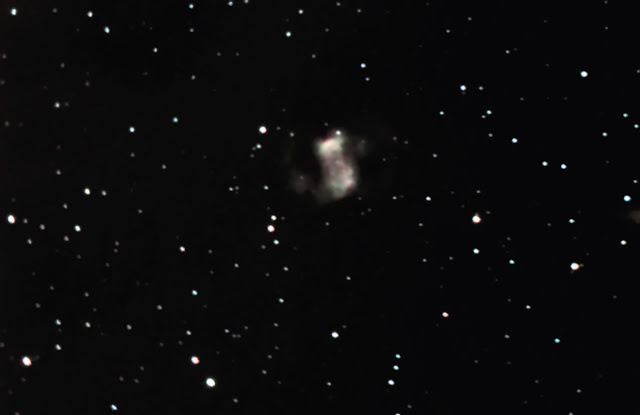25 each 3 minute images. (no discards!) The image also includes one 5 minute image. I switched over from ST-4 guiding to pulseguiding. Man what a difference! Anyway here are the results.
Visit TheSkySearchers.com forum. A friendly bunch of amateur astronomers.TheSkySearchers.com  www.webewebbiers.com/Astronomy.htm
www.webewebbiers.com/Astronomy.htm
Friday, October 29, 2010
Wednesday, October 13, 2010
NGC7662 Blue Snowball
I finally got my polar alignment dialed in now. So gave this a shot.
From Wikipedia:
NGC 7662 otherwise known as the Blue Snowball Nebula is a planetary nebula located in the constellation Andromeda.
The distance to this nebula is not known with any real accuracy. According to the Skalnate Pleso Catalogue (1951) the distance of NGC 7662 is about 1,800 light years, the actual diameter about 20,000 AU. In a more recent survey of the brighter planetaries, C.R.O'Dell (1963) derived a distance of 1,740 parsecs or about 5,600 light years, increasing the actual size to 0.8 light year, or nearly 50,000 AU. It has a faint central star that is variable, with a magnitude range of 12 to 16.[3] The central star is a bluish dwarf with a continuous spectrum and a computed temperature of about 75,000K. The nuclei of the planetary nebulae are among the hottest stars known.[4]
NGC 7662 is a fairly popular planetary nebula for casual observers. A small refractor will reveal a star-like object with slight nebulosity. A 6 in. telescope with a magnification around 100x will reveal a slightly bluish disk. Telescopes of diameter 16" or greater may reveal slight color and brightness variations in the interior.
From Wikipedia:
NGC 7662 otherwise known as the Blue Snowball Nebula is a planetary nebula located in the constellation Andromeda.
The distance to this nebula is not known with any real accuracy. According to the Skalnate Pleso Catalogue (1951) the distance of NGC 7662 is about 1,800 light years, the actual diameter about 20,000 AU. In a more recent survey of the brighter planetaries, C.R.O'Dell (1963) derived a distance of 1,740 parsecs or about 5,600 light years, increasing the actual size to 0.8 light year, or nearly 50,000 AU. It has a faint central star that is variable, with a magnitude range of 12 to 16.[3] The central star is a bluish dwarf with a continuous spectrum and a computed temperature of about 75,000K. The nuclei of the planetary nebulae are among the hottest stars known.[4]
NGC 7662 is a fairly popular planetary nebula for casual observers. A small refractor will reveal a star-like object with slight nebulosity. A 6 in. telescope with a magnification around 100x will reveal a slightly bluish disk. Telescopes of diameter 16" or greater may reveal slight color and brightness variations in the interior.
Sunday, October 10, 2010
Saturday, October 9, 2010
M76 Little Dumbbell
Here's last nights attempt at the Little Dumbbell. 60 each 1 minute images guided.
From Wikipedia:
The Little Dumbbell Nebula, also known as Messier 76, NGC 650/651, the Barbell Nebula, or the Cork Nebula [1], is a planetary nebula in the constellation Perseus. It was discovered by Pierre Méchain in 1780 and included in Charles Messier's catalog of comet-like objects as number 76. It was first recognised as a planetary nebula in 1918 by the astronomer Heber Doust Curtis. However, there is some contention to this claim, as Isaac Roberts in 1891 did suggest that M76 might be similar to the Ring Nebula (M57), being instead as seen from the side view. [2] The structure is now classed as a bipolar planetary nebula (BPNe).[3]
Distance to M76 is currently estimated as 780 parsecs or 2,500 light years [4], making the average dimensions about 0.378 pc. (1.23 ly.) across. [5]
The total nebula shines at the apparent magnitude of +10.1 with its central star or planetary nebula nucleus (PNN) at +15.9v (16.1B) magnitude.[1] The UV-light from the PNN is expanding outer layers that form the present nebula, and has the surface temperature of about 88,400 K. The whole planetary nebula is approaching us at −19.1km.s-1. [6]
The Little Dumbbell Nebula derives its common name from its resemblance to the Dumbbell Nebula (M27) in Vulpecula. It was originally thought to consist of two separate emission nebulae and was thus given two catalog numbers in the NGC 650 and 651. Some consider this object the faintest and hardest to see objects in Messier's list.
From Wikipedia:
The Little Dumbbell Nebula, also known as Messier 76, NGC 650/651, the Barbell Nebula, or the Cork Nebula [1], is a planetary nebula in the constellation Perseus. It was discovered by Pierre Méchain in 1780 and included in Charles Messier's catalog of comet-like objects as number 76. It was first recognised as a planetary nebula in 1918 by the astronomer Heber Doust Curtis. However, there is some contention to this claim, as Isaac Roberts in 1891 did suggest that M76 might be similar to the Ring Nebula (M57), being instead as seen from the side view. [2] The structure is now classed as a bipolar planetary nebula (BPNe).[3]
Distance to M76 is currently estimated as 780 parsecs or 2,500 light years [4], making the average dimensions about 0.378 pc. (1.23 ly.) across. [5]
The total nebula shines at the apparent magnitude of +10.1 with its central star or planetary nebula nucleus (PNN) at +15.9v (16.1B) magnitude.[1] The UV-light from the PNN is expanding outer layers that form the present nebula, and has the surface temperature of about 88,400 K. The whole planetary nebula is approaching us at −19.1km.s-1. [6]
The Little Dumbbell Nebula derives its common name from its resemblance to the Dumbbell Nebula (M27) in Vulpecula. It was originally thought to consist of two separate emission nebulae and was thus given two catalog numbers in the NGC 650 and 651. Some consider this object the faintest and hardest to see objects in Messier's list.
Subscribe to:
Posts (Atom)


